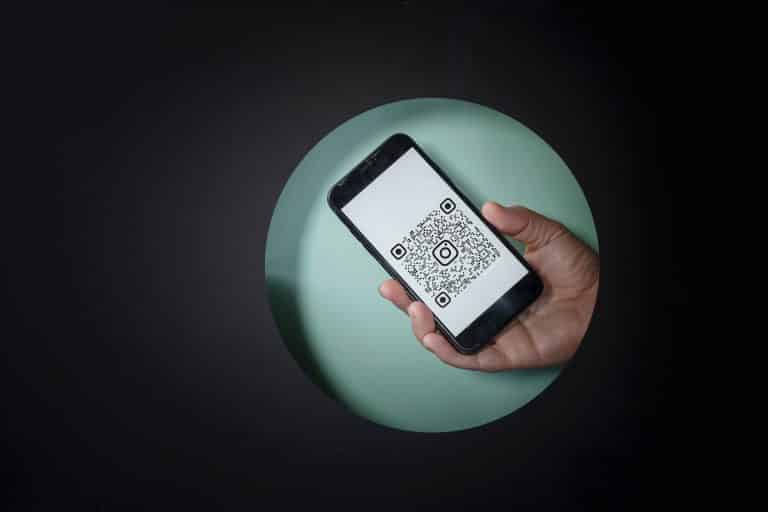QR code security is a widely discussed topic throughout the world, but in general, QR codes are safe. Issues with security only emerge when malevolent websites like malware hosts or phishing pages utilise QR codes to redirect people.
QR Code: What Is It and How Does It Work?
Any equipment, such as a smartphone, tablet, or computer system with a QR reader, can read a QR code quickly and efficiently. Typically, it appears as follows:

It’s a two-dimensional barcode or optical label that holds data about the object to which it’s connected or associated. It frequently includes location, identifier, or tracker data that directs users to a certain website or application.
Also Read: How Can Hackers Hack Social Media Accounts?
What Is the Origin of QR Codes?
In Japan, the car sector created the first QR code in 1994. Masahiro Hara from Denso Wave, a Denso subsidiary that makes automated identification systems, industrial robots, and programmable logic controllers, came up with the idea for this device (PLCs). Anyone unfamiliar with PLCs should know that they are a type of industrial computer control system that keeps tabs on what is being plugged in and out of it.
The QR code was based on a Go game board in the beginning. And what was the point of it in the first place? It’s impossible not to track cars as they’re being built.
What Are They Good For?
More sectors now utilise QR codes for commercial tracking and convenience-oriented purposes targeting smartphone users since they were first introduced in Japan. As a result, they may show text to users, load a web page on their devices, connect to a wireless network, and do other things as well.
Are They Vulnerable to Hacking?
Hacking QR codes would require changing the square matrix of pixelated dots used to make them, which cannot be done. As a result, when QR code security is discussed, it refers to hacking of the data associated with a specific QR code rather to the code itself.
QR Code Use Is Linked to What Kind of Risks?
The following risks can be associated with QR codes that are obtained from unreliable sources or from unknown individuals or organisations:
- Phishing
The webpage that a QR code is linked to can be hacked by an attacker and become “malicious.” How? To begin, they set up a phishing site on which to trick unsuspecting victims. When someone “reads” the QR code, they’re redirected to a phishing page that’s been hacked to seem like the legitimate website.
QR codes that lead to phishing pages can be printed and posted in public areas by attackers in some situations. Scanning the code may lead to the loss of personal information to hackers.
- Malware
By creating a download page that automatically instals malware onto a user’s device, hackers may carry out an attack. They then hack the website that the widely spread QR code leads to, just like in phishing. Visitors to the infected website may be routed to the malware’s host page as a result.
Is it Possible to Prevent Security Threats Caused by QR Codes?
Here are a few pointers to help you avoid being hacked by QR codes:
- Verify for Signs of QR Code Tampering on Printed Material
This method comes in helpful when reading QR codes placed in public areas that are printed on paper. Check to see whether a malicious sticker has been applied in lieu of the original code.
- Confirm that the QR Code Generator is working properly.
Make sure the firm that developed the QR code is authentic before scanning it. For their schemes, hackers have been known to construct fictitious firms. They also employ incredibly attractive ruses, such as contests or giveaways, but all you’ll get in return is your personal data or even money that’s been taken from your account.
- Shortened Links Should Be Avoided at All Costs
A QR code’s Uniform Resource Link (URL) will be shown when you scan it. It’s advisable not to click on any truncated links that appear. Shortened URLs are commonly used by hackers to avoid detection.
- Never divulge private information on a website you’re not familiar with.
Any website that asks you for personal information should be avoided. Likewise, if you have no prior knowledge of or relationship with the website to which a QR code directs you, avoid visiting it.
- Use a Mobile Security App to Protect Your Devices
Mobile devices, such as your smartphone and laptop, should receive the same care and attention as your desktop or laptop. They target mobile devices in the same way that cybercriminals attack unprotected personal computers.
Conclusion
QR codes themselves, as you’ve seen, are typically safe, but the websites to which they route you or redirect you may not be as well protected. Before you even consider reading QR codes, take the essential precautions to protect yourself against phishing and malware infection.

